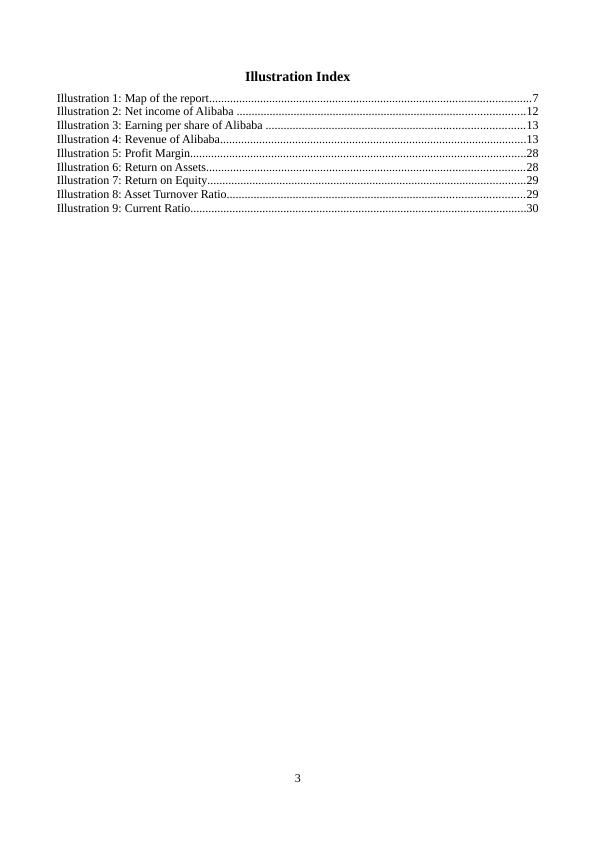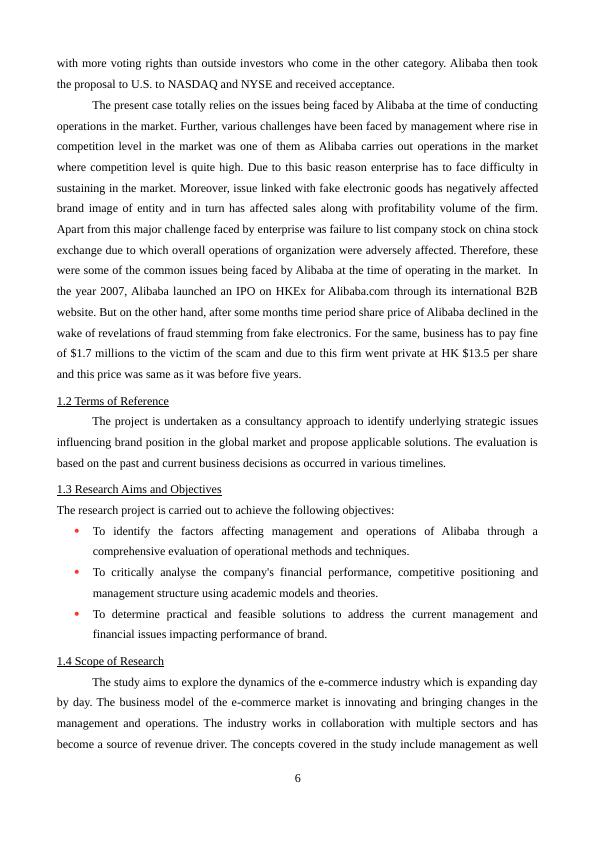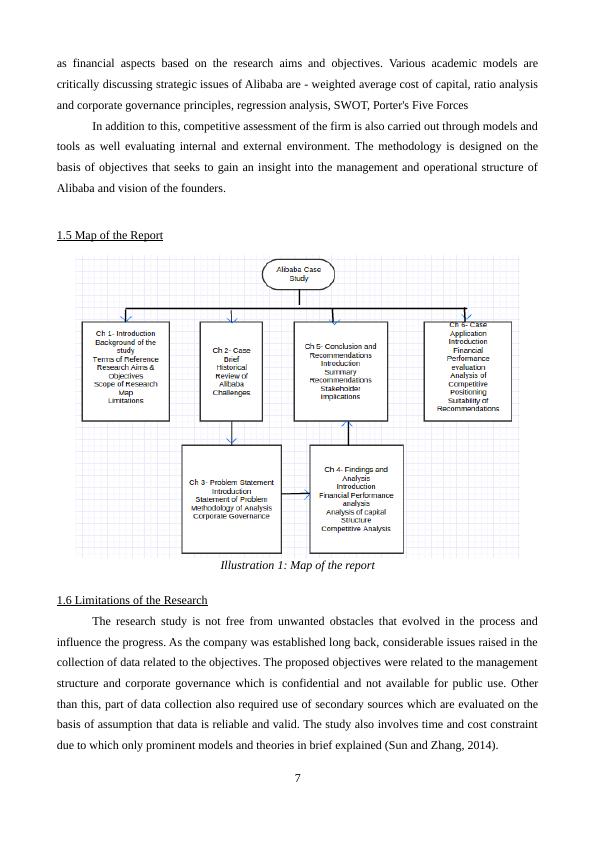Case Study on Alibaba Assignment
50 Pages14542 Words46 Views
Added on 2019-12-03
Case Study on Alibaba Assignment
Added on 2019-12-03
ShareRelated Documents
ALIBABA GOES PUBLIC
1
1

Table of Contents
CHAPTER 1: INTRODUCTION.........................................................................................................5
1.1 Background of the study.......................................................................................................5
1.2 Terms of Reference...............................................................................................................6
1.3 Research Aims and Objectives..............................................................................................6
1.4 Scope of Research.................................................................................................................6
1.5 Map of the Report.................................................................................................................7
1.6 Limitations of the Research..................................................................................................7
CHAPTER 2: CASE BRIEF................................................................................................................9
CHAPTER 3: PROBLEM STATEMENT..........................................................................................15
3.1Statement of the Problems in the case.................................................................................15
3.2 Research methods ..............................................................................................................17
3.3 Relevant literature review ..................................................................................................18
3.4 Proposed plan of analysis ...................................................................................................20
3.5 Sources of data....................................................................................................................23
3.6 Ethical issues ......................................................................................................................23
CHAPTER 4: FINDINGS AND ANALYSIS.....................................................................................24
4.1 An assessment of the current position ..............................................................................24
4.2 Alternative business scenario..............................................................................................25
4.3 Resource constraint Evaluation ..........................................................................................26
Chapter 5: Proposed solution to problems .........................................................................................34
5.1 Integrated discussion analysis ............................................................................................34
5.2 Recommendation and proposed plan for action .................................................................35
5.3 Critical assumptions to success...........................................................................................36
5.4 Implication for Stakeholders...............................................................................................37
5.5 Limitations of study , scope for future research .................................................................38
Chapter 6: Application of learning ....................................................................................................39
6.1Discriotion of comparator company's Situation .................................................................39
6.2 Testing the recommendation on comparator company......................................................39
REFERENCES...................................................................................................................................49
2
CHAPTER 1: INTRODUCTION.........................................................................................................5
1.1 Background of the study.......................................................................................................5
1.2 Terms of Reference...............................................................................................................6
1.3 Research Aims and Objectives..............................................................................................6
1.4 Scope of Research.................................................................................................................6
1.5 Map of the Report.................................................................................................................7
1.6 Limitations of the Research..................................................................................................7
CHAPTER 2: CASE BRIEF................................................................................................................9
CHAPTER 3: PROBLEM STATEMENT..........................................................................................15
3.1Statement of the Problems in the case.................................................................................15
3.2 Research methods ..............................................................................................................17
3.3 Relevant literature review ..................................................................................................18
3.4 Proposed plan of analysis ...................................................................................................20
3.5 Sources of data....................................................................................................................23
3.6 Ethical issues ......................................................................................................................23
CHAPTER 4: FINDINGS AND ANALYSIS.....................................................................................24
4.1 An assessment of the current position ..............................................................................24
4.2 Alternative business scenario..............................................................................................25
4.3 Resource constraint Evaluation ..........................................................................................26
Chapter 5: Proposed solution to problems .........................................................................................34
5.1 Integrated discussion analysis ............................................................................................34
5.2 Recommendation and proposed plan for action .................................................................35
5.3 Critical assumptions to success...........................................................................................36
5.4 Implication for Stakeholders...............................................................................................37
5.5 Limitations of study , scope for future research .................................................................38
Chapter 6: Application of learning ....................................................................................................39
6.1Discriotion of comparator company's Situation .................................................................39
6.2 Testing the recommendation on comparator company......................................................39
REFERENCES...................................................................................................................................49
2

Illustration Index
Illustration 1: Map of the report...........................................................................................................7
Illustration 2: Net income of Alibaba ................................................................................................12
Illustration 3: Earning per share of Alibaba ......................................................................................13
Illustration 4: Revenue of Alibaba......................................................................................................13
Illustration 5: Profit Margin................................................................................................................28
Illustration 6: Return on Assets..........................................................................................................28
Illustration 7: Return on Equity..........................................................................................................29
Illustration 8: Asset Turnover Ratio...................................................................................................29
Illustration 9: Current Ratio................................................................................................................30
3
Illustration 1: Map of the report...........................................................................................................7
Illustration 2: Net income of Alibaba ................................................................................................12
Illustration 3: Earning per share of Alibaba ......................................................................................13
Illustration 4: Revenue of Alibaba......................................................................................................13
Illustration 5: Profit Margin................................................................................................................28
Illustration 6: Return on Assets..........................................................................................................28
Illustration 7: Return on Equity..........................................................................................................29
Illustration 8: Asset Turnover Ratio...................................................................................................29
Illustration 9: Current Ratio................................................................................................................30
3

Index of Tables
Table 1: Types of Ratios.....................................................................................................................20
Table 2: Factors affecting cost of capital............................................................................................21
Table 3: SWOT Analysis....................................................................................................................24
Table 4: Alibaba Financial Details and Ratio calculation...................................................................26
Table 5: WACC Calculation...............................................................................................................30
Table 6: Beta Calculation...................................................................................................................31
Table 7: Regression Statistics.............................................................................................................32
Table 8: Correlation coefficient..........................................................................................................32
4
Table 1: Types of Ratios.....................................................................................................................20
Table 2: Factors affecting cost of capital............................................................................................21
Table 3: SWOT Analysis....................................................................................................................24
Table 4: Alibaba Financial Details and Ratio calculation...................................................................26
Table 5: WACC Calculation...............................................................................................................30
Table 6: Beta Calculation...................................................................................................................31
Table 7: Regression Statistics.............................................................................................................32
Table 8: Correlation coefficient..........................................................................................................32
4

CHAPTER 1: INTRODUCTION
1.1 Background of the study
Alibaba, established in 1999 as an e-commerce company in China. It was the first online
marketplace in China that provides businesses and consumers a single platform for sell and
purchase. Within two years, the company was able to raise funds from likes of Goldman Sachs,
Softbank, Fidelity, etc. In the next year, Alibaba was able to achieve its first profit led by the
expansion in market and consumer base. In 2003, Alibaba founded Taobao which is a consumer e-
commerce platform. Even after the years of establishment, the brand was not able to gain consumer
and business confidence for pre-payment of goods (Rizzi, 2013). It was identified that sellers were
resistant to ship the goods before the payment. On the other hand, consumers were reluctant to pay
the price before the delivery. This led to the introduction of payment service platform Alipay in
2004. In the next year, Alibaba entered into strategic partnership with Yahoo's China business.
Strategic problems with the business started to begin in 2007 when it launched its IPO on
Hong Kong Stock Exchange for Alibaba.com. The stock received appreciation from the market
forces and prices increased by three times on the first trading day. But soon it declined below the
average levels in only 30 days. After several attempts to revive the stock price and positive brand
image among the shareholders, Alibaba.com was privatised in 2012 (Sun and Zhang, 2014). Share
prices continued to move in the downward trend as more scams and frauds revealed from the
internal company accounts that hugely impacts its value and image in the market. Alibaba paid $1.7
million to fraud victims and privatised Alibaba.com at HK$13.5 which was the same price at the
time of IPO launch.
In 2011, Alibaba founder separated the Alipay business out of the group holding. This raised
concern among the Yahoo which lead to reduction in ownership stake to 50%. In middle of all these
events the performance of brand is nowhere affected as Taobao and Tmall occupies 70% of the
package delivery and covering 80% of the nation's e-commerce market. There were huge
differences in the value of transactions at Alibaba and value of revenue generated. In the highly
competitive market, transaction at Alibaba were more than double than that of Amazon and almost
triple to eBay's (Tan, Tyler and Manica, 2007). More into this account is the volume of transactions
realised on Alibaba.com on Single Day sale on November 2013. The volume of Alibaba was larger
than the combined value of good sold on eBay and Amazon on Thanks Giving Day, Cyber Monday
and Black Friday.
Later in 2013, Alibaba proposed dual class equity stock on Hong Kong Stock Exchange
which was rejected two times. It was proposed that one class of equity would be for management,
5
1.1 Background of the study
Alibaba, established in 1999 as an e-commerce company in China. It was the first online
marketplace in China that provides businesses and consumers a single platform for sell and
purchase. Within two years, the company was able to raise funds from likes of Goldman Sachs,
Softbank, Fidelity, etc. In the next year, Alibaba was able to achieve its first profit led by the
expansion in market and consumer base. In 2003, Alibaba founded Taobao which is a consumer e-
commerce platform. Even after the years of establishment, the brand was not able to gain consumer
and business confidence for pre-payment of goods (Rizzi, 2013). It was identified that sellers were
resistant to ship the goods before the payment. On the other hand, consumers were reluctant to pay
the price before the delivery. This led to the introduction of payment service platform Alipay in
2004. In the next year, Alibaba entered into strategic partnership with Yahoo's China business.
Strategic problems with the business started to begin in 2007 when it launched its IPO on
Hong Kong Stock Exchange for Alibaba.com. The stock received appreciation from the market
forces and prices increased by three times on the first trading day. But soon it declined below the
average levels in only 30 days. After several attempts to revive the stock price and positive brand
image among the shareholders, Alibaba.com was privatised in 2012 (Sun and Zhang, 2014). Share
prices continued to move in the downward trend as more scams and frauds revealed from the
internal company accounts that hugely impacts its value and image in the market. Alibaba paid $1.7
million to fraud victims and privatised Alibaba.com at HK$13.5 which was the same price at the
time of IPO launch.
In 2011, Alibaba founder separated the Alipay business out of the group holding. This raised
concern among the Yahoo which lead to reduction in ownership stake to 50%. In middle of all these
events the performance of brand is nowhere affected as Taobao and Tmall occupies 70% of the
package delivery and covering 80% of the nation's e-commerce market. There were huge
differences in the value of transactions at Alibaba and value of revenue generated. In the highly
competitive market, transaction at Alibaba were more than double than that of Amazon and almost
triple to eBay's (Tan, Tyler and Manica, 2007). More into this account is the volume of transactions
realised on Alibaba.com on Single Day sale on November 2013. The volume of Alibaba was larger
than the combined value of good sold on eBay and Amazon on Thanks Giving Day, Cyber Monday
and Black Friday.
Later in 2013, Alibaba proposed dual class equity stock on Hong Kong Stock Exchange
which was rejected two times. It was proposed that one class of equity would be for management,
5

with more voting rights than outside investors who come in the other category. Alibaba then took
the proposal to U.S. to NASDAQ and NYSE and received acceptance.
The present case totally relies on the issues being faced by Alibaba at the time of conducting
operations in the market. Further, various challenges have been faced by management where rise in
competition level in the market was one of them as Alibaba carries out operations in the market
where competition level is quite high. Due to this basic reason enterprise has to face difficulty in
sustaining in the market. Moreover, issue linked with fake electronic goods has negatively affected
brand image of entity and in turn has affected sales along with profitability volume of the firm.
Apart from this major challenge faced by enterprise was failure to list company stock on china stock
exchange due to which overall operations of organization were adversely affected. Therefore, these
were some of the common issues being faced by Alibaba at the time of operating in the market. In
the year 2007, Alibaba launched an IPO on HKEx for Alibaba.com through its international B2B
website. But on the other hand, after some months time period share price of Alibaba declined in the
wake of revelations of fraud stemming from fake electronics. For the same, business has to pay fine
of $1.7 millions to the victim of the scam and due to this firm went private at HK $13.5 per share
and this price was same as it was before five years.
1.2 Terms of Reference
The project is undertaken as a consultancy approach to identify underlying strategic issues
influencing brand position in the global market and propose applicable solutions. The evaluation is
based on the past and current business decisions as occurred in various timelines.
1.3 Research Aims and Objectives
The research project is carried out to achieve the following objectives:
To identify the factors affecting management and operations of Alibaba through a
comprehensive evaluation of operational methods and techniques.
To critically analyse the company's financial performance, competitive positioning and
management structure using academic models and theories.
To determine practical and feasible solutions to address the current management and
financial issues impacting performance of brand.
1.4 Scope of Research
The study aims to explore the dynamics of the e-commerce industry which is expanding day
by day. The business model of the e-commerce market is innovating and bringing changes in the
management and operations. The industry works in collaboration with multiple sectors and has
become a source of revenue driver. The concepts covered in the study include management as well
6
the proposal to U.S. to NASDAQ and NYSE and received acceptance.
The present case totally relies on the issues being faced by Alibaba at the time of conducting
operations in the market. Further, various challenges have been faced by management where rise in
competition level in the market was one of them as Alibaba carries out operations in the market
where competition level is quite high. Due to this basic reason enterprise has to face difficulty in
sustaining in the market. Moreover, issue linked with fake electronic goods has negatively affected
brand image of entity and in turn has affected sales along with profitability volume of the firm.
Apart from this major challenge faced by enterprise was failure to list company stock on china stock
exchange due to which overall operations of organization were adversely affected. Therefore, these
were some of the common issues being faced by Alibaba at the time of operating in the market. In
the year 2007, Alibaba launched an IPO on HKEx for Alibaba.com through its international B2B
website. But on the other hand, after some months time period share price of Alibaba declined in the
wake of revelations of fraud stemming from fake electronics. For the same, business has to pay fine
of $1.7 millions to the victim of the scam and due to this firm went private at HK $13.5 per share
and this price was same as it was before five years.
1.2 Terms of Reference
The project is undertaken as a consultancy approach to identify underlying strategic issues
influencing brand position in the global market and propose applicable solutions. The evaluation is
based on the past and current business decisions as occurred in various timelines.
1.3 Research Aims and Objectives
The research project is carried out to achieve the following objectives:
To identify the factors affecting management and operations of Alibaba through a
comprehensive evaluation of operational methods and techniques.
To critically analyse the company's financial performance, competitive positioning and
management structure using academic models and theories.
To determine practical and feasible solutions to address the current management and
financial issues impacting performance of brand.
1.4 Scope of Research
The study aims to explore the dynamics of the e-commerce industry which is expanding day
by day. The business model of the e-commerce market is innovating and bringing changes in the
management and operations. The industry works in collaboration with multiple sectors and has
become a source of revenue driver. The concepts covered in the study include management as well
6

as financial aspects based on the research aims and objectives. Various academic models are
critically discussing strategic issues of Alibaba are - weighted average cost of capital, ratio analysis
and corporate governance principles, regression analysis, SWOT, Porter's Five Forces
In addition to this, competitive assessment of the firm is also carried out through models and
tools as well evaluating internal and external environment. The methodology is designed on the
basis of objectives that seeks to gain an insight into the management and operational structure of
Alibaba and vision of the founders.
1.5 Map of the Report
Illustration 1: Map of the report
1.6 Limitations of the Research
The research study is not free from unwanted obstacles that evolved in the process and
influence the progress. As the company was established long back, considerable issues raised in the
collection of data related to the objectives. The proposed objectives were related to the management
structure and corporate governance which is confidential and not available for public use. Other
than this, part of data collection also required use of secondary sources which are evaluated on the
basis of assumption that data is reliable and valid. The study also involves time and cost constraint
due to which only prominent models and theories in brief explained (Sun and Zhang, 2014).
7
critically discussing strategic issues of Alibaba are - weighted average cost of capital, ratio analysis
and corporate governance principles, regression analysis, SWOT, Porter's Five Forces
In addition to this, competitive assessment of the firm is also carried out through models and
tools as well evaluating internal and external environment. The methodology is designed on the
basis of objectives that seeks to gain an insight into the management and operational structure of
Alibaba and vision of the founders.
1.5 Map of the Report
Illustration 1: Map of the report
1.6 Limitations of the Research
The research study is not free from unwanted obstacles that evolved in the process and
influence the progress. As the company was established long back, considerable issues raised in the
collection of data related to the objectives. The proposed objectives were related to the management
structure and corporate governance which is confidential and not available for public use. Other
than this, part of data collection also required use of secondary sources which are evaluated on the
basis of assumption that data is reliable and valid. The study also involves time and cost constraint
due to which only prominent models and theories in brief explained (Sun and Zhang, 2014).
7

The financial figures from the annual reports and online websites are considered for analysis
assuming that these represent the actual performance of the brand. The validity and reliability of
financial figures are important to accurately assess the performance and recommend solutions. The
academic models are applied on the information obtained from different sources.
The recommendations are based on the data findings discussed using the models like
WACC, ratios and regression which are assumed that they provide similar results in all the markets
and dynamics. Further research is required into the suitability and applicability of models related
with the industry specific forces. There is little research related with the global forces that affect the
business decisions.
8
assuming that these represent the actual performance of the brand. The validity and reliability of
financial figures are important to accurately assess the performance and recommend solutions. The
academic models are applied on the information obtained from different sources.
The recommendations are based on the data findings discussed using the models like
WACC, ratios and regression which are assumed that they provide similar results in all the markets
and dynamics. Further research is required into the suitability and applicability of models related
with the industry specific forces. There is little research related with the global forces that affect the
business decisions.
8

End of preview
Want to access all the pages? Upload your documents or become a member.
Related Documents
Challenges with ESOL in China: Reasons for Lack of Progress and Recommendationslg...
|42
|15208
|220
The relationship between dividend payout and firm performance PDFlg...
|49
|15379
|33
Supply Chain Management 65 Running Head: Supply Chain Managementlg...
|71
|20533
|482
Use of Artificial Intelligence in Project Managementlg...
|63
|15751
|86
XXX in China: Marketing Strategies for Expansionlg...
|68
|16736
|25
Management Analytics: Descriptive and Regression Analysislg...
|9
|1867
|402
